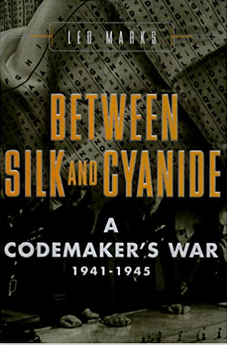 Recently I read a book by British Special Operations Executive cryptographer Leo Marks called “Between Silk and Cyanide“. This title documents the real story of the code war between Germany and the Allies in World War 2. It is a title I highly recommend reading to get a sense of the real history of what happened in SOE during World War 2 and the aftermath.
Recently I read a book by British Special Operations Executive cryptographer Leo Marks called “Between Silk and Cyanide“. This title documents the real story of the code war between Germany and the Allies in World War 2. It is a title I highly recommend reading to get a sense of the real history of what happened in SOE during World War 2 and the aftermath.
In the book, Marks details the challenges of being a cryptographer in the badly underfunded and unappreciated Special Operations Executive hereby called SOE.
Leo was the son of Benjamin Marks, the owner of Marks’ bookshop located at 84 Charing Cross Road. in London This bookshop was well known throughout the U.K. and many of the agents and wartime personnel Marks dealt with knew of the shop and his father. These associations served him well on many occasions.
Marks was introduced at an early age to cryptography when his father showed him Edgar Allan Poe‘s story, The Gold-Bug. Leo’s father encouraged these mental exercises as part of educating his son.
From this early interest, Marks demonstrated considerable skill at codebreaking by deciphering the secret price codes which his father wrote inside the covers of books. The bookshop subsequently became famous as a result of the book 84, Charing Cross Road, which was based on correspondence between American writer Helene Hanff and the shop’s chief buyer, Frank Doel.
Cryptographer, Misfit and SOE Agent

Leo Marks in 2000. Photo taken by Steve Crook, Fair use, https://en.wikipedia.org/w/index.php?curid=1694235
Marks was conscripted in January 1942 and trained as a cryptographer; apparently he demonstrated the ability to complete one week’s work in decipherment exercise in a few hours. Unlike the rest of his class, who were sent to the main British code breaking center at Bletchley Park, Marks was regarded as a misfit, partially due to his refusal to go along with the standard solution sets that he found tedious and boring. He solved cryptographic problems using his own methods which did not set well with the teachers at Bletchley.
To put it mildly, Marks was smarter than his instructors.
Thus, he was not accepted at Bletchley but was instead assigned to the newly formed Special Operations Executive (SOE) at 64 Baker Street in Westminster. SOE was set up to train agents to operate behind enemy lines in occupied Europe and to assist local resistance groups. SOE has been described as “a mixture of brilliant brains and bungling amateurs”. It was this collection of misfits whose efforts won the war through their audacity, refusal to conform and innovative solutions to combat and intelligence gathering.
Marks was accepted into SOE in June of 1942 on the mistaken notion that he was the son of Sir Simon Marks and that Leo might use his family influence to get Canteen facilities for SOE because they were desperately needed. Leo actually KNEW Michael Marks and was cagey enough to let his interviewer proceed under this mistaken notion with the promise that Leo would secure the funding for the canteen facility. Coincidentally, the funding came through soon after Marks joined SOE and he never fessed up until after the war about this amusing mix up.
Marks shared the story that SOE’s staff tested him to see if he could easily crack codes. He was disappointed when it took him all day to decipher a code he had been expected to finish in 20 minutes, because the SOE testing instructor had forgotten to supply the cipher key, and he had to break the code which SOE had regarded as secure. This happy accident secured Mark’s future at SOE.
SOE was about to jettison Marks to the curb, believing he didn’t have any talent when he revealed he had not been given the cipher key and that he had worked out the code on his own, per his training from Bletchley Park. It was then that SOE’s leadership realized they had scored a coup in getting a talented cryptographer on staff and he was immediately placed into his secret work and held a very high clearance as a result. Marks ability to crack codes and invent new ones was legendary. He soon became one of the leading cryptographers in the war effort and was in high demand amongst the various services. Bletchley Park realized quickly they had let go of a true talent and one can imagine they were kicking themselves for doing so.
The fact was he was a genius and it was only much later that he was referred to by a leading cryptographer at SIS as “the one who got away”. It is interesting to see how many truly smart people who don’t fit the normal cogs of compliant robots do find their way despite being mislabeled as “misfits” by the blind and dumb of many organizations then and now.
Marks briefed many Allied agents sent into occupied Europe, including Noor Inayat Khan, the Grouse/Swallow team of four Norwegian Telemark heavy water plant saboteurs and his own close friend ‘Tommy’ Yeo-Thomas, nicknamed “the White Rabbit.” In an interview which accompanied the DVD of the film Peeping Tom, Marks quoted General Eisenhower as saying that SOE’s code department shortened the war by three months, saving countless lives.
Special Operations Executive

SOE Logo featuring a dagger.
Per Wikipedia: “SOE was officially formed on 22 July 1940 under Minister of Economic Warfare Hugh Dalton, from the amalgamation of three existing secret organizations. SOE’s sole purpose was to conduct espionage, sabotage and reconnaissance in occupied Europe (and later, also in occupied Southeast Asia) against the Axis powers, and to aid local resistance movements.
Few people were aware of SOE’s existence. Those who were part of it or liaised with it were sometimes referred to as the “Baker Street Irregulars“, after the location of its London headquarters. It was also known as “Churchill’s Secret Army” or the “Ministry of Ungentlemanly Warfare“. Its various branches, and sometimes the organization as a whole, were concealed for security purposes behind names such as the “Joint Technical Board” or the “Inter-Service Research Bureau“, or fictitious branches of the Air Ministry, Admiralty or War Office.”
Dalton took political responsibility for the SOE and recorded in his diary that Churchill told him: “And now go and set Europe ablaze”. It was under this mandate that Dalton and the whole of SOE operated.
SOE was referred to publicly as the “Inter-Service Research Bureau” but was more aptly called by it’s more buccaneer titles such as “Churchill’s Secret Army” or the “Ministry of Ungentlemanly Warfare”. I find the latter name to be the most apt calling card and it continues to be a truism even in today’s wars with Special Forces being at the pointed end of the spear.
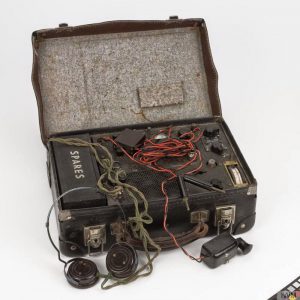
Type A Mk III Suitcase Radio used by Special Operations Executive used by wireless operators in occupied Europe and Asia. The life expectancy of SOE wireless operators was six weeks before capture.
SOE fought a nearly constant battle with the existing intelligence agencies in the U.K. due in part due to the British reluctance to play as dirty or even worse than what the Germans were doing to all of Europe. In no small part is it clearly alluded in Mark’s book that there was a “not invented here” sense of jealousy that pervaded the Secret Intelligence Service (SIS) and which was a constant thorn in SOE’s side.
Many attempts were made to absorb and dissolve SOE by SIS and there was a great deal of infighting that went on. SOE called SIS by the name “C” and often added other colorful terms to complete the “C” designation.
It can be readily stated that after reading Leo’s book, I rightly asked who’s side the War Department and SIS were on after seeing the sorts of battles that went on in trying to defeat SOE from their mission.
The Ministry of Ungentlemanly Warfare

Colin Gubbins. By derivative work: McZusatz – This file was derived from: ColinGubbins1.jpg:, CC BY-SA 3.0, https://commons.wikimedia.org/w/index.php?curid=425033
If it had not been for the leadership by Colin Gubbins whose sheer force of personality made SOE into the great guerilla organization it was, the war may have been lost due to the vastly different views that SIS and many in the War Office held concerning “fair play” in war.
This sense of “fair play” in war and the uniquely British horror of unconventional and “Dirty Tricks” fighting traced its roots back to the angry British accusations against American forces for not fighting fairly in the American revolution. American tactics of using cover, surprise attacks and guerrilla warfare were alien concepts to the British Army.
It took the events of World War II for leading British and Western military organizations to wake up to the fact that the face of war was changing and could not be fought in the same ways as had been done in the past.
SOE suffered from these British sensibilities governing the conduct of war. The old establishment view on war that pervaded the War Department at the beginning of WW2 had become hopelessly antiquated by the time the Germans began their quest conquer Europe and eventually the entire globe.
Gubbins rightly recognized that to win against the Nazis, he had to create a fighting force that was even dirtier than they were and set about to create an army of unconventional special forces soldiers. This created an internal battle of ideals that lasted throughout much of the war although by war’s end, the British military began to recognize the value of special forces operations.
Gubbins was also responsible for setting up the secret Auxiliary Units, a commando force based around the Home Guard, to operate on the flanks and to the rear of German lines if the United Kingdom were invaded during Operation Sea Lion, Germany’s planned invasion. Once it became clear that Hitler’s planned invasion of England wouldn’t take place due to Germany not having the resources or will to crush England, Gubbins found himself focused on his new role in the SOE and to take the unconventional war to the enemy.
In September 1943 GHQ Middle East, the Foreign Office, and the Joint Intelligence Committee sought to remove SOE’s autonomy. Despite having the firm support of Dalton’s successor, Lord Selborne, the resulting directive placed SOE’s field operations under the direction of theater commanders. Sir Charles Hambro, the executive head of SOE, resigned in protest. Subsequently, Gubbins was appointed as his replacement. SOE’s position nevertheless remained precarious, and in January 1944 there was a further attempt to dismantle SOE, following the revelation that SOE’s operations in the Netherlands had been penetrated by Nazi intelligence. — Wikipedia
Gubbins and his associates put together a dirty tricks squad of the most devious minds in Britain to create new types of weapons never seen in warfare. The inventions of the Limpet Mine, the clamshell mine, the PIAT anti-tank weapon and the Hedgehog anti-sub weapon proved to be some of the most decisive weapons ever created by human beings up to that point and these transformed the war to blunt the Nazi offensive dramatically. Some of these weapons were under development prior to the war and Gubbin’s time because there were those in the government who recognized that Britain would need to fight a different kind of war. They knew the conventional military establishment was hopelessly outclassed by the new weapons the Nazis were fielding and by the dangerously fixed mindset of the British War Department towards innovation.

SOE developed Welrod Pistol for field operatives.
SOE developed a wide range of weapons at their many labs and proving grounds. The classic Welrod pistol pictured at left, is a nearly silent killing pistol remains in use by intelligence services to this day and figures as a weapon in many modern World War 2 shooter games including my own favorite “Sniper Elite IV”.
This pistol started with single-shot 32 and was changed later on to 9mm caliber due to performance issues with the 32 caliber weapon. The Welrod features the ability to be broken down and assembled quickly and is a perfect silent killing tool for special operations work. It has a 6 to 8 round magazine enabling the operating more than one chance to take down a target before having to reload. The pistol uses rubber baffles to silence the pistol. The baffles last up to around 15 shots and then are replaced to keep the weapon silenced in field operations.
Gubbins also implemented training schools for commando operations and deployed guerrilla forces in such numbers that Hitler ordered that commandos be shot on sight or capture, directly violating the Geneva Convention and which placed many Nazis at the end of hanging ropes at wars end due to these deaths being classified as war crimes.
The Ministers of Silent Killing

William Fairbairn
Gubbins hired two men, William Fairbairn and Eric Sykes, who were some of the most deadly fighters to walk the planet. This unlikely pair of war fighters arrived in the form of two elderly men who turned up in Britain to offer their services to the war effort and who miraculously found their way to Gubbins after being treated less than kindly by the War Office.
When Gubbins saw just how much they knew about killing and dirty fighting, they were offered the chance to teach their craft to countless numbers of students at a facility in Scotland. The end product of these killing schools saw countless dead Nazis racked up as casualties to the new way of fighting.
Fairbairn and Skyes Impressive Resume’s
William Ewart Fairbairn (28 February 1885 – 20 June 1960) was a British Royal Marine and police officer. He developed hand-to-hand combat methods for the Shanghai Police during the interwar period, as well as for the allied special forces during World War II.
He created his own fighting system known as Defendu. Notably, this included innovative pistol shooting techniques and the development of the Fairbairn-Sykes Fighting Knife. — Wikipedia
Fairbairn authored a number of popular books on fighting techniques that are still in print today.

Eric Sykes
Eric Anthony Sykes (5 February 1883 – 12 May 1945), born Eric Anthony Schwabe, was a soldier and firearms expert. He is most famous for his work with William E. Fairbairn in the development of the eponymous Fairbairn-Sykes Fighting Knife and modern British Close Quarters Battle (CQB) martial arts during World War II.
Originally working for an import/export company selling weapons in East Asia, he claimed he volunteered for and served in the British Army as a sharpshooter on the Western Front during World War I. Returning to China in 1917, he joined the volunteer branch of the Shanghai Municipal Police (SMP) Specials with the rank of Inspector in 1926. — Wikipedia
Sykes ended every self-defense lecture with his trademark phrase “and then, kick him in the testicles” as this method ensures that regardless of the effectiveness of the given tactic used, the assailant would be at least moderately incapacitated.
Sadly, Sykes died alone in May 1945 due to heart trouble after a quick retirement in April of that year. He lived just long enough to witness the Germans surrender. He and Fairbairn had a falling out and had parted company some years earlier with Fairbairn having moved over to OSS to teach their agents fighting techniques while Sykes stayed on at SOE until nearly the end of the war on Germany. One can only hope that Fairbairn did grieve for his former friend and that they both rest in peace.
Their combined design of the classic fighting knife, the Fairbairn-Sykes Fighting Knife is still produced and is a deadly killing tool in the right hands.
A simple search on YouTube shows video of the techniques that Fairbairn and Sykes used in teaching combat techniques.
SOE Headquarters

SOE headquarters at 64 Baker Street in Westminster, England as it is today. A small green memorial plaque is see next to the door detailing SOE’s presence at this location.
SOE’s headquarters at 64 Baker Street were the center of operations for the agency and housed some of the most brilliant minds in England. The site remains today as a store front that is marked by a small plate recording that the SOE once led a most ambitious intelligence fight against the Nazis from this innocuous location near London’s heart.
The code wars were striking because of the the battles that took place with Leo Marks fighting equally with his own department in the SOE leadership to understand the dangers of the SIS poem codes and the fact that he correctly surmised that the Dutch SOE agents had been thoroughly compromised by the Germans, resulting in almost all Dutch SOE agents inserted in the field being captured, killed or exploited for use by the Nazis.
Marks did everything possible to save these agents but it was the inter-agency war and politics of it that doomed these agents. Had SIS been more on board with SOE and worked together as a team, it is likely that the Dutch disaster would have been avoided for the most part and the SOE efforts would have been more successful in Holland. Predictably, SIS (C) tried to capitalize on this and dissolve SOE on grounds of incompetence. This move was successfully beaten back, allowing SOE to continue it’s mission.
In the following audio interview (about 22 minutes), Leo Marks details a short overview of his time at SOE and the many battles and strange aspects of working at SOE that he had to contend with. It is filled with humor and irony as he details his experiences during World War 2:
 Audio Speech by Leo Marks. Click to listen to the interview
Audio Speech by Leo Marks. Click to listen to the interview
SOE had much better successes elsewhere, despite the pervasive refusal by SOE and SIS to handle the fact that the codes had been broken and that transmissions to field agents were, in fact, communications to and from Nazis in Holland rather than agents of SOE. Marks fought a lonely battle to stop the use of these codes and was in constant friction with his superiors over it.

SOE provided essential support with sabotage operations to assist with the successful Normandy Invasion on D-Day.
The Nazis played SOE expertly. SOE found itself trapped in a SIS/War Office battle that made admitting the problem worse than severing the contacts and stopping sending agents to their doom. It was a classic case of analysis paralysis.
Marks did his best to stop the agents being sent into harm’s way but couldn’t stop the insanity on his own and had to go along with the fiction until it finally came to a point that even the Nazis couldn’t hide the fact of the compromised Dutch operations any longer.
Germany broke the deadlock, openly mocking the British and for which SOE openly mocked the Germans back for what was in store for them.
Marks later exit debrief at the end of the war and SOE’s demise spoke honestly about the Dutch disaster. He spoke candidly about what he was up against. The reception he received from his interviewing officer led him to believe that the truth was known at the highest levels and that he was merely underscoring his point of view and experiences.
The New Codes – Silks and One Time Pads
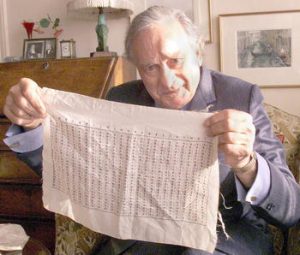
Leo Marks holding up a SOE Silk Code Sheet. Codes were cut off the sheet after each use with up to 200 WOKs (worked out keys) codes per sheet. Photo: Dave Caulkin / Associated Press
Marks created new codes using silk “WOK” (worked out keys) codes and one time pads that were far easier to use and made the code harder for the Germans to break. The “silk codes” were printed on silk cloth and very easy to use.
This consisted of a cloth with multiple codes printed on it that allowed an agent to use a one-time code to encrypt their messages to London. Getting the silk to produce the codes in wartime London was easier said than done and Marks moved heaven and earth to procure the silk, photographers and printers to make them a reality.
Additionally, Marks was credited with inventing the letter one-time pad, but while he did independently discover the method, he later found it already in use at Bletchley.
Agents used this additional encryption method as well to send very secure messages to and from London. One-time pad codes are still useful to this day. I myself used such a pad to decipher orders to follow in mock aerial combat in vintage fighter aircraft in the deserts of Southern California. These pads are simple to use and effective.
He pioneered the development of fake messages to hide the increase in traffic needed to coordinate the D-Day invasion. These techniques were altogether original and successfully fooled the Germans into wasting time decrypting useless traffic. Just prior to the invasion, Marks created a fake code set, complete with silk code sheets and one time pad ciphers to attach to the body of a German double agent who was tossed out of a Allied plane over Germany. The Germans found the codes and likely were duped into believing England had inserted SOE agents throughout Germany, thus adding to the paranoia that the SS and Gestapo had to be feeling as the war neared it’s end.
Marks innovation and “build it because you need to” mentality impressed the cryptographic establishment. His final contribution was a diplomatic code that was a brilliant as it was simple. He innovated it just prior to his exit and passed it on for others to develop further.
D-Day
SOE’s contribution to D-Day cannot be overstated as they coordinated disaster upon the Nazis with sabotage operations that directly blunted the Nazi response to the D-Day invasion of June 6, 1944 at Normandy. SOE and French Resistance sabotage of train cars transporting German tanks and railway lines as well as communications infrastructure and road sabotage contributed greatly to the Allies defeating the Germans in France and taking the country back from the Nazis.
Once D-Day was over, SOE’s days were numbered and many people began to see the end approaching. Transfers began to occur and it was clear that the members of the organization needed to address their own futures and to find a jumping off point to go on.
Poems, Tragedy and After the War
Marks left the SOE at war’s end and despite being urged to permanently move over to SIS and refused to do so due to the residual hostility at SIS and his knowledge that he wouldn’t have a long career there if he stayed on. He did a short stint there for three months and saw the writing on the wall with how the SOE agents who did transfer were treated. He had enough for one lifetime of service to his country by my read of his story.
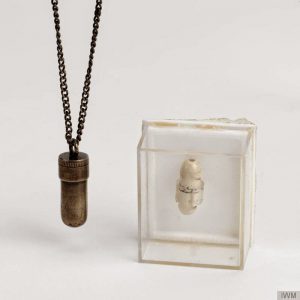
Suicide pill container and cyanide capsule used by agents if captured.
Marks was awarded the MBE (Member of the Order of the British Empire) in 1945 for his wartime work with SOE. He never forgot the experiences he had in SOE and the agents he saw off to duty, many of which died at the hands of the Nazis.
Some agents died in battles with the Nazis, others captured and tortured or executed. Agents were provided with cyanide capsules as a means of opting out of the torture that was sure to be inflicted on them upon capture.
Marks detailed these deaths in his book and is is clear that the deaths haunted him the remainder of his life.
He went on to have a career in the arts and entertainment and often wrote poetry. The poem “The Life That I have” (see end of article for the poem) that he wrote with a female SOE agent Violette Szabo (poems were a form of code used in agent communications in the field by SOE agents).
Marks never liked the poem codes and fought a year-long battle to have the poem codes disposed of in favor of silk cipher codes and one-time pads that were infinitely more secure and safe than the easily broken poem codes. His battle is detailed in great detail in his book “Between Silk and Cyanide”.

SOE Agent Violette Szabo
Marks wrote the poem in Christmas 1943 about a girlfriend, Ruth, who had recently died in an air crash in Canada. He gave it to Szabo to use for her field poem code during his mission brief with her before she was inserted into the field for operational duty.
In 2012 Max Hastings wrote that Szabo was “adored by the men and women of SOE both for her courage and endless infectious Cockney laughter”, while Leo Marks remembered her as “A dark-haired slip of mischief….She had a Cockney accent which added to her impishness”
Szabo later was later captured and killed by the Nazis. The poem he gave her has been shared many times and is a moving tribute to her memory and to his girlfriend, Ruth.
SOE was decommissioned and broken up in January 1946. It’s duties and materials were transferred to SIS who immediately set about destroying SOE’s operational assets with what could be called a streak of revenge for SOE’s “crime” of stealing the limelight.
A mysterious fire that destroyed nearly 80% of the SOE records broke out around this time and it is inferred that the fire was intentional. What we do know of SOE comes from the surviving records and from information from it’s former agents who spoke out in increasing numbers from the 1960s onward when it was clear that the Official Secrets Act has run it’s course on SOE’s members all those years later`. Very few in the public knew of SOE until it’s exploits became more well known in the latter half of the 20th century. Precious few agents and SOE personnel survive today.
SOE supported existing sister organizations like the SAS, American OSS which became the CIA and others whose missions continue to this day. SOE’s legacy remains a legendary story whose exploits are worth reading about and knowing.
Special Forces Club

Special Forces Club Crest
Not content to sit idle after he was unceremoniously dumped from military service after the war, Colin Gubbins created the Special Forces Club in England that few know of even to this day.
Originally the club allowed only SOE members to come into it’s doors but eventually opened to SIS, SAS commandos and other intelligence professionals to pay honor to the Special Forces of Britain. There, agents could freely talk and socialize in a place that, outside of the club, the “Official Secrets Act” kept them from divulging until many years had transpired.
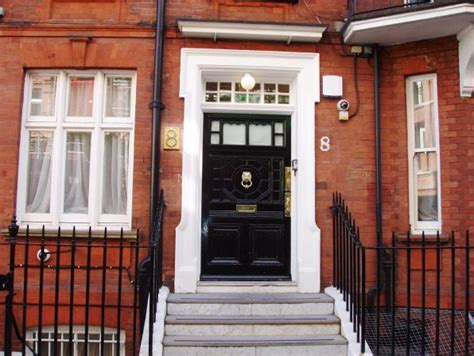
The facade to the Special Forces Club and it’s formidable doorway. A place of memories, secrets and intrigue.
The club is distinct in the fact that most people do not know about it, even in the neighborhood it resides. It remains a exclusive enclave that allows for private conversations amongst intelligence and special forces professionals to mingle and relax.
Leo was indeed a welcome member of the club due to his many contributions to the war effort.
It took some digging but I found his obituary on the now defunct (and with valuable and timeless content!) 64-Baker-Street.Org website which mentioned the Special Forces Club and that Leo was indeed a regular member there.

The imposing lion door knocker at the Special Forces Club door.
The short sentence “He was an habitue of the Special Forces Club.” was shared in his obituary and I was pleased to see he was rewarded with the recognition he so richly deserved from his peers. Leo went on to write a memoir of his experience, was interviewed many times on the BBC and was recorded in video and audio appearances that survive today in which he shares his experiences with a sense of humor and humility.
The Special Forces Club preserves such memories and the experiences of those agents and personnel who sacrificed their time and lives to insure the Nazis did not take over the world and to those who have done the same since World War 2. We are forever in their debt.
Leo passed away on January 15, 2001 after a lifetime of speaking, creating and writing after suffering from prostate cancer. Per his entry at the IMDB: “His body was donated to University of East London for medical science.”
Leo never was a soldier in the classical sense, but it is my personal belief that Leo was a consummate special forces soldier of his own unique caliber. May he rest in peace.

Lysander aircraft used for SOE insertions and extractions as well as arms deliveries. Taken & submitted by Paul Maritz, CC BY-SA 3.0 <http://creativecommons.org/licenses/by-sa/3.0/>, via Wikimedia Commons
The Life That I Have
The life that I have
Is all that I have
And the life that I have
Is yours
The love that I have
Of the life that I have
Is yours and yours and yours.
A sleep I shall have
A rest I shall have
Yet death will be but a pause
For the peace of my years
In the long green grass
Will be yours and yours and yours.
–Leo Marks
We are in the debt of these agents and people who fought so hard to defeat the Nazis. May their memory never be forgotten.
I have created a SOE Virtual Cemetery on FindAGrave for members of SOE whose profiles are on the site. More will be added in the future.

Image of the Special Operations dedication seal at 64 Baker Street in Westminster.
Sources: Much of the content of this article was sourced from Wikipedia, current web sites and defunct websites on Archive.Org with my own writing and observations thus interspersed.
